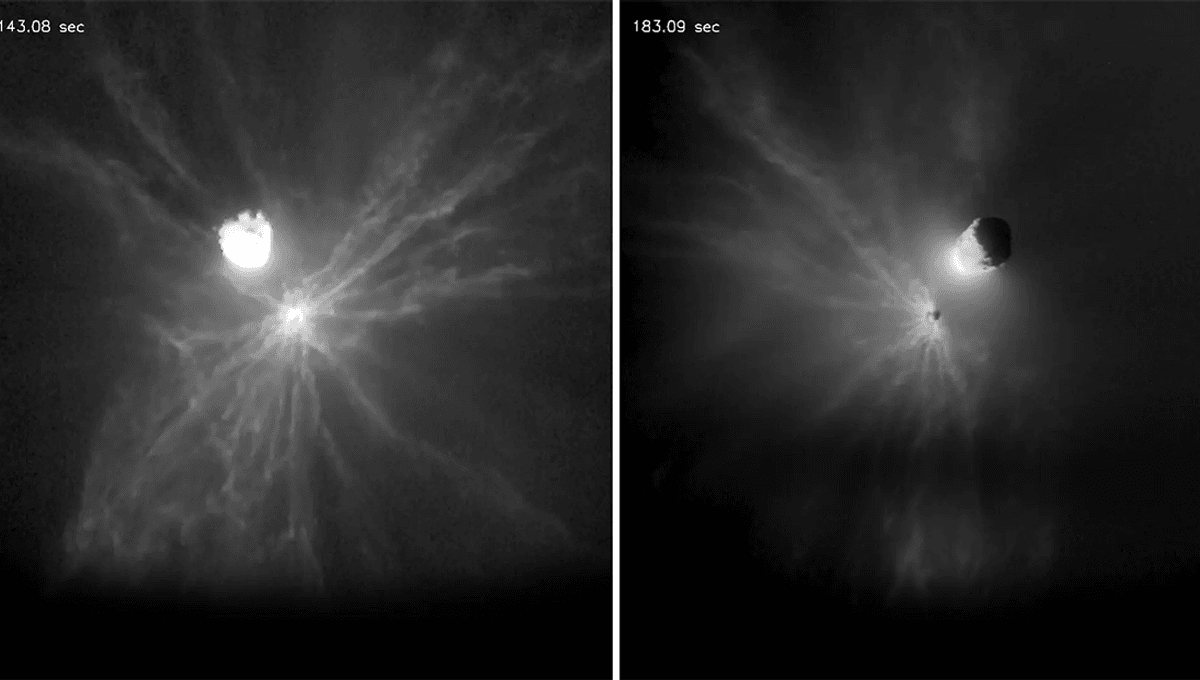"Something Unknown Is At Work Here": Unexpected Results From NASA Mission To Deflect Asteroid

"Something Unknown Is At Work Here": Unexpected Results From NASA Mission To Deflect Asteroid
In 2022, NASA slammed a spaceship into an asteroid about the size of the Great Pyramid of Giza in an attempt to alter its course.
The mission was a success, and demonstrated that it is possible to redirect objects in space, great news for a planet that isn't a huge fan of being wiped out by asteroids. As well as successfully redirecting the asteroid Dimorphos, it sent huge boulders flying off from the loosely bound asteroid, ranging in size from 1 to 7 meters (3-23 feet) in diameter. A new paper tracking boulders resulting from the impact has found that they gave a push in unexpected directions, which could potentially complicate any future asteroid deflection mission. "There has yet to be a full accounting of the total momentum in all directions, but the ejecta cone spreads out sideways, as well as in the direction of the incoming spacecraft," the team explains in their paper. "Thus, a significant component of the momentum, possibly several times that contributing to the β factor, was carried out perpendicular to Dimorphos’s velocity vector. To fully understand the impact’s effect on Dimorphos’s orbit, it is necessary to explore the spatial distribution of the debris field and use it to ascertain the net momentum of all its components." The team analyzed the distribution of 104 boulders imaged by the Light Italian Cubesat for Imaging of Asteroids (LICIACube), which accompanied the Double Asteroid Redirection Test (DART) mission. These boulders, which range in size from 0.2 to 3.6 meters (0.7 to 11.8 feet) in radius, shot away from Dimorphos at speeds up to 52 meters per second (116 miles per hour) after impact. While redirecting the asteroid was expected – it was the whole point of the mission – the direction these boulders took was less so. "We saw that the boulders weren't scattered randomly in space," Tony Farnham, lead author of the paper and a research scientist at UMD's Department of Astronomy, said in a statement. "Instead, they were clustered in two pretty distinct groups, with an absence of material elsewhere, which means that something unknown is at work here." The largest of the debris clusters contained around 70 percent of the ejected objects, and headed south at high velocities at a shallow angle to the asteroid's surface. The team believes that these were likely the remains of large boulders that were shattered upon impact with DART's solar panels. "DART's solar panels likely hit two big boulders, called Atabaque and Bodhran, on the asteroid," second author Jessica Sunshine, a professor of astronomy and geology at UMD, added. "Evidence suggests that the southern cluster of ejected material is probably made up of fragments from Atabaque, a 3.3-meter-radius boulder." According to the team, the boulders unleashed by the impact carried more than three times the momentum of the DART spacecraft impacting it. What's more, given that the ejected boulders were generally perpendicular to the direction of DART, the mission could have tilted the asteroid's orbital plane by up to one degree, potentially sending it rolling and tumbling into space. "If an asteroid was tumbling toward us, and we knew we had to move it a specific amount to prevent it from hitting Earth, then all these subtleties become very, very important," Sunshine added. "You can think of it as a cosmic pool game. We might miss the pocket if we don't consider all the variables." While not a threat to the Earth, future asteroid deflection missions will have to take into account the complicated dynamics seen here. "Deep Impact hit a surface that was essentially very small, uniform particles, so its ejecta was relatively smooth and continuous," Sunshine, who was deputy principal investigator on NASA's Deep Impact mission, continued. "And here, we see that DART hit a surface that was rocky and full of large boulders, resulting in chaotic and filamentary structures in its ejecta patterns." "Comparing these two missions side-by-side gives us this insight into how different types of celestial bodies respond to impacts, which is crucial to ensuring that a planetary defense mission is successful." The team suggests that a full description of the momentum of the surface boulders is necessary to work out how future impacts will affect the space object in question. Fortunately, the European Space Agency's Hera mission will arrive at Dimorphos in 2026, in order to further analyze the impact. "We succeeded in deflecting an asteroid, moving it from its orbit," Farnham added. "Our research shows that while the direct impact of the DART spacecraft caused this change, the boulders ejected gave an additional kick that was almost as big. That additional factor changes the physics we need to consider when planning these types of missions." The study is published in The Planetary Science Journal.


